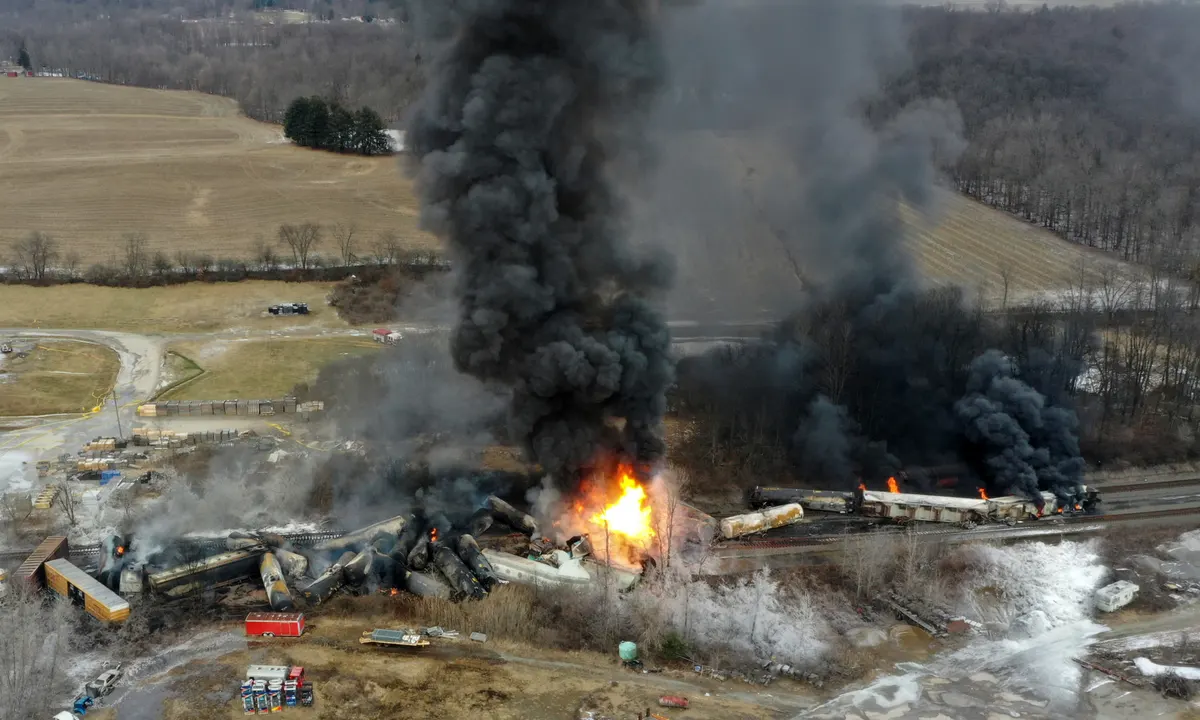National Transportation Safety Board faults Norfolk Southern and contractors with unnecessary pollution
The National Transportation Safety Board said that Norfolk Southern and its contractors unnecessarily burned toxic chemicals – including vinyl chloride – from its tank cars during the freight train derailment in East Palestine, Ohio, last February, unleashing hazardous fumes into the air.
In a board meeting on Tuesday, the NTSB said that an overheated wheel bearing caused the derailment, adding that Norfolk Southern and its contractors “misinterpreted and disregarded evidence” in reaching its decision to execute a controversial controlled burn over concerns that the vinyl chloride could potentially explode.
Following Norfolk Southern and its contractors’ decision to vent and burn the chemicals, plumes of black smoke filled the air of East Palestine for days. The derailment and fumes prompted between 1,500 and 2,000 of the town’s approximately 4,900 residents to evacuate. It also triggered what residents describe as various health issues including nausea, diarrhea and headaches due to the chemical exposure.
Vinyl chloride, a colorless and highly flammable gas used to make plastic, can cause a slew of health issues including drowsiness, loss of coordination, visual and auditory abnormalities, nausea, headache and, in some cases, death, according to the Centers for Disease Control and Prevention.
At Tuesday’s board meeting, the NTSB said that OxyVinyls, the manufacturer of the vinyl chloride, informed Norfolk Southern that there was no risk of explosion as the chemicals were being stored in tank cars that were sturdy enough to withstand crashes, according to Politico. The outlet further reported that the vinyl chloride had been stabilized to prevent any chemical reactions.
However, Norfolk Southern and its contractors did not inform the local fire chief about not needing to burn the chemicals. Other hazardous chemicals released during the derailment included butyl acrylate, 2-ethylhexyl acrylate and ethylene glycol monobutyl ether.
Paul Stancil, an NTSB hazardous material investigator, reportedly also said during the board meeting: “Norfolk Southern’s contractors, who were in control of the derailment scene assessment, compromised the integrity of the vent and burn decision by withholding complete … information from the incident commander,” as reported by Politico.
Stancil added: “Norfolk Southern and its contractors continued to assert the necessity of a vent and burn, even though available evidence should have led them to re-evaluate their initial conclusion.”
Pushing back against NTSB’s findings, Norfolk Southern said that it did not withhold information from local officials and that they could have spoken to OxyVinyls’ employees who were at the scene of the derailment.
“There was no obstacle to them making their views known to the ultimate decision-makers,” Norfolk Southern said in a statement. The company also said that OxyVinyls provided it with “conflicting information”.
“The vent and burn effectively avoided a potential uncontrolled explosion. There was no loss of life, injuries, or damage to property, and contractors took steps to manage environmental impact,” Norfolk Southern added.
NTSB chair Jennifer Homendy noted during the meeting that “the absence of fatality or injury doesn’t mean the presence of safety”, according to the Associated Press.
In May, Norfolk Southern agreed to pay a $310m settlement with the US government over the disastrous derailment. In addition to paying a $15m civil penalty for violating clean-water laws, the company agreed to pay hundreds of millions in cleanup costs.
The settlement came a month after the company agreed to pay $600m in a class-action lawsuit settlement that it said would resolve all class-action claims within a 20-mile radius from the derailment.
Hazardous chemicals that were released into the air following the derailment spread to 16 states, according to a report released last month.
“We saw the chemical signal from this fire at a lot of sites and far away,” David Gay, a University of Wisconsin researcher and lead author of the report, said in June.
“There was more than we ever would have guessed,” he said, adding: “That can distribute pollution a long way … and it was a nasty little fire with lots of emissions.”




